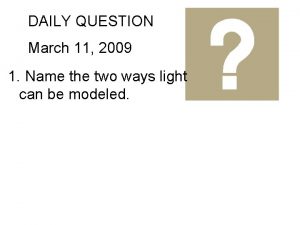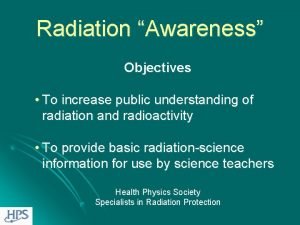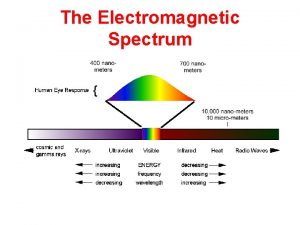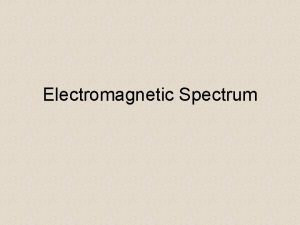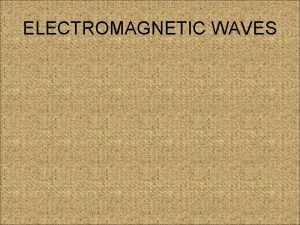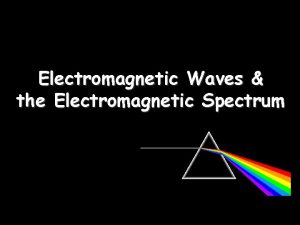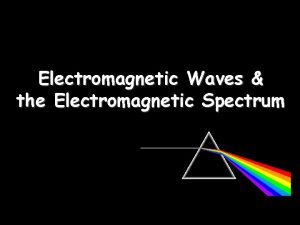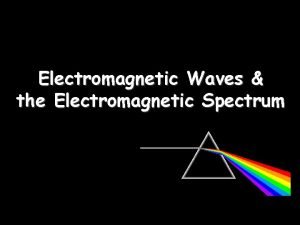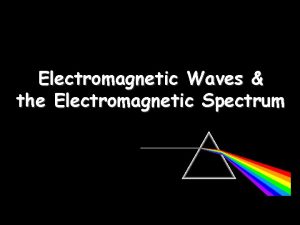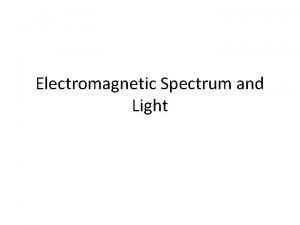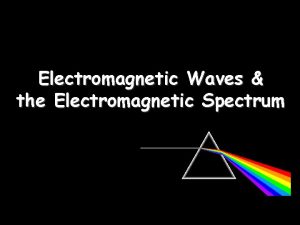The Electromagnetic Spectrum What are Waves Waves a
















- Slides: 16

The Electromagnetic Spectrum

What are Waves? Waves – a back and forth motion that travels from one place to another

Electromagnetic Spectrum • Electromagnetic waves are formed when an electric field (shown as blue arrows) couples with a magnetic field (shown as red arrows).

Electromagnetic Spectrum *The electromagnetic spectrum is more familiar to you than you might think. The microwave you use to heat your food and the cell phones you use are part of the Electromagnetic Spectrum. The light that our eyes can see is also part of the electromagnetic spectrum. This visible part of the electromagnetic spectrum consists of the colors that we see in a rainbow - from reds and oranges, through blues and purples. * Each of these colors actually corresponds to a different wavelength of light.

Electromagnetic Spectrum • Waves in the electromagnetic spectrum vary in size from very long radio waves the size of buildings, to very short gamma-rays smaller than the size of the nucleus of an atom.

Radio Waves Frequency: Longest wavelength in the electromagnetic spectrum Type: Radios, TVs, cell phones How do we see it? -Radio telescopes are dishes made out of conducting metal that reflect radio waves to a focus point.

Microwaves Frequency: wavelengths can be measured in centimeters Type: microwaves, Doppler radar, transmit information How do we see it? -Radar was developed to detect objects and determine their range (or position) by transmitting short bursts of microwaves. The strength and origin of "echoes" received from objects that were hit by the microwaves is then recorded.

Infrared Light Frequency: Waves vary in wavelength. The longer, far infrared wavelengths are about the size of a pin head and the shorter, near infrared ones are the size of cells, or are microscopic. Type: Far infrared waves are thermal (heat from the sun, a fire, or the sidewalk). Shorter wavelengths are the ones used by your remote control. How do we see it? Since the primary source of infrared radiation is heat or thermal radiation, any object which has a temperature radiates in the infrared. Scientists use satellites to measure the infrared of Earth, the sun, and other galaxies. Some snake species can actually see infrared waves.

Visible Light Frequency: Visible light waves are the only electromagnetic waves we can see. We see these waves as the colors of the rainbow. Each color has a different wavelength. Red has the longest wavelength and violet has the shortest wavelength. When all the waves are seen together, they make white light. Each color in a rainbow corresponds to a different wavelength of the electromagnetic spectrum.

X-Rays Continued How do we se it? *X-ray machines *Astronomers put X-ray telescopes and detectors on satellites

Visible Light Continued Types: The colors of objects and light waves (ex: the sun or even a light bulb) OR How do we see it? Cones in our eyes are receivers for these tiny visible light waves.

Ultra Violet Frequency: Shorter wavelengths than visible light. Types: The sun’s light that causes sunburns How do we see it? Humans cannot see UV light, but some insects such as bees can. Astronomers have to put ultraviolet telescopes on satellites to measure the ultraviolet light from stars and galaxies - and even closer things like the Sun!

X-rays Frequency: As the wavelengths of light decrease, they increase in energy. X-rays have smaller wavelengths and therefore higher energy than ultraviolet waves. Type: X-rays of bones and teeth and objects in space (ex: black holes)

Gamma Rays Frequency: Gamma-rays have the smallest wavelengths and the most energy of any other wave in the electromagnetic spectrum Types: Things like supernova explosions (the way massive stars die), neutron stars and pulsars, and black holes are all sources of celestial gamma-rays. How do we see it? Gamma-ray telescopes use a process called Compton scattering, where a gamma-ray strikes an electron and loses energy, similar to a cue ball striking an eight ball.

• Today, these gamma -ray bursts, which happen at least once a day, are seen to last for fractions of a second to minutes, popping off like cosmic flashbulbs from unexpected directions, flickering, and then fading after briefly dominating the gamma-ray sky.

Sources • http: //science. hq. nasa. gov/kids/imagers/e ms/index. html
 Insidan region jh
Insidan region jh Electromagnetic spectrum energy
Electromagnetic spectrum energy Difference between matter waves and electromagnetic waves
Difference between matter waves and electromagnetic waves Light and sound travel in waves true or false
Light and sound travel in waves true or false Electromagnetic waves vs mechanical waves
Electromagnetic waves vs mechanical waves Similarities of mechanical and electromagnetic waves
Similarities of mechanical and electromagnetic waves Similarities of mechanical and electromagnetic waves
Similarities of mechanical and electromagnetic waves How are rainbows made
How are rainbows made Mechanical waves vs electromagnetic waves venn diagram
Mechanical waves vs electromagnetic waves venn diagram Lowest point of a wave
Lowest point of a wave What is the electromagnetic spectrum
What is the electromagnetic spectrum Electromagnetic spectrum foldable
Electromagnetic spectrum foldable Em spectrum mnemonic
Em spectrum mnemonic Objectives
Objectives Electromagnetic spectrum
Electromagnetic spectrum How do matter and energy interact when waves are generated
How do matter and energy interact when waves are generated Which colour has the longest wavelength
Which colour has the longest wavelength












